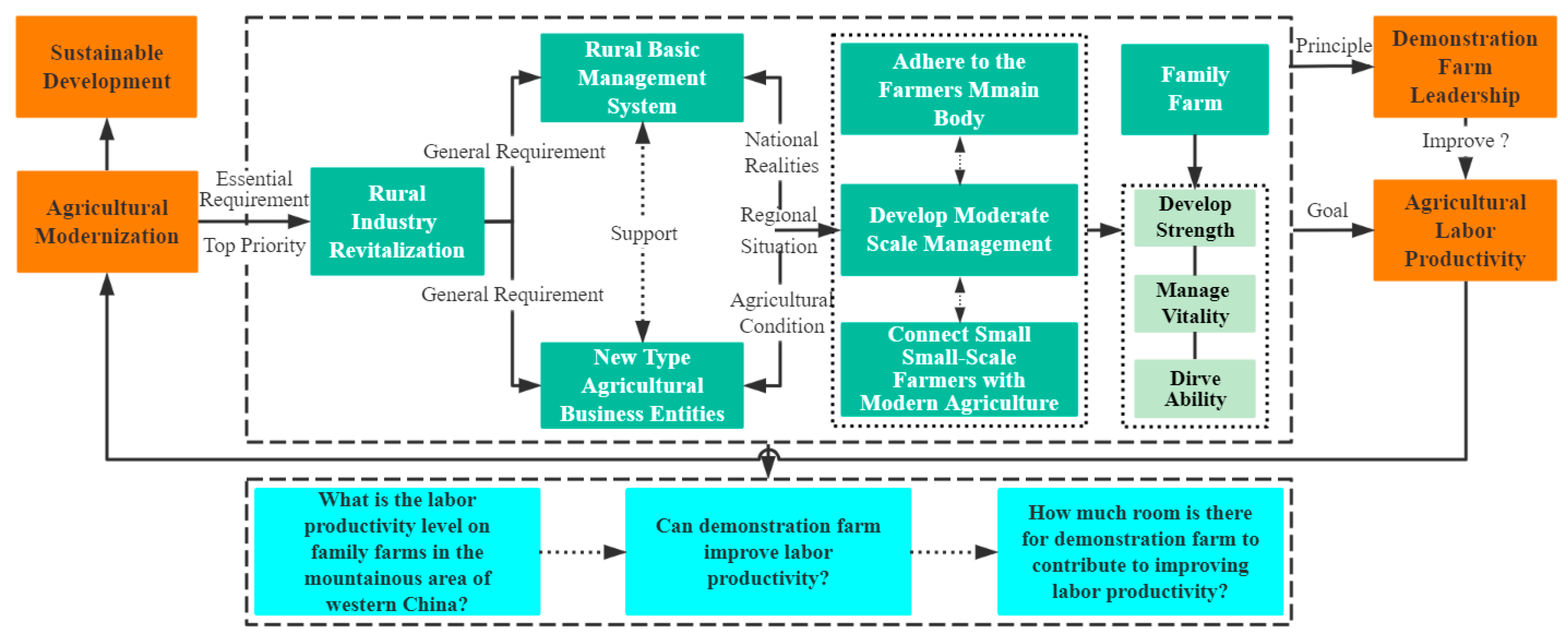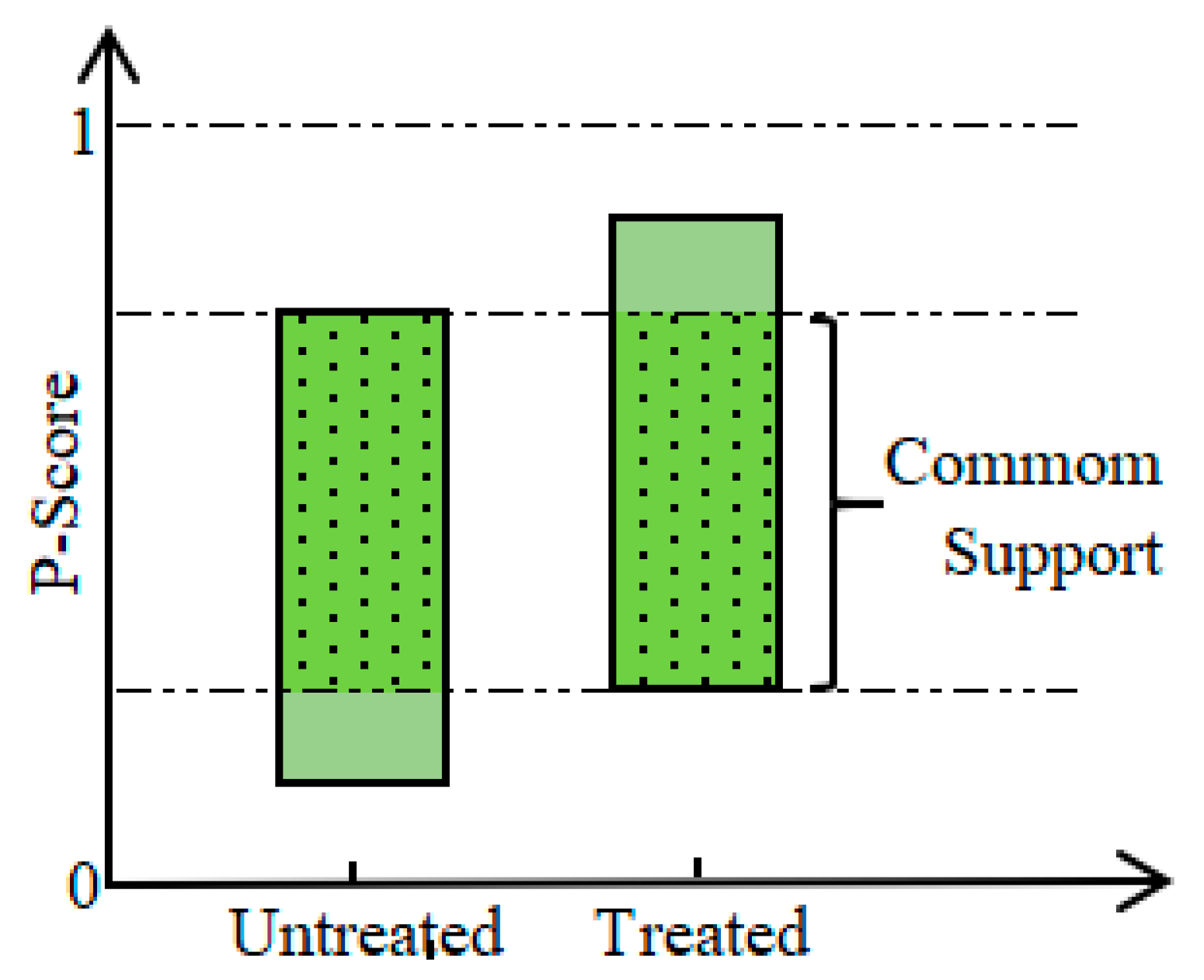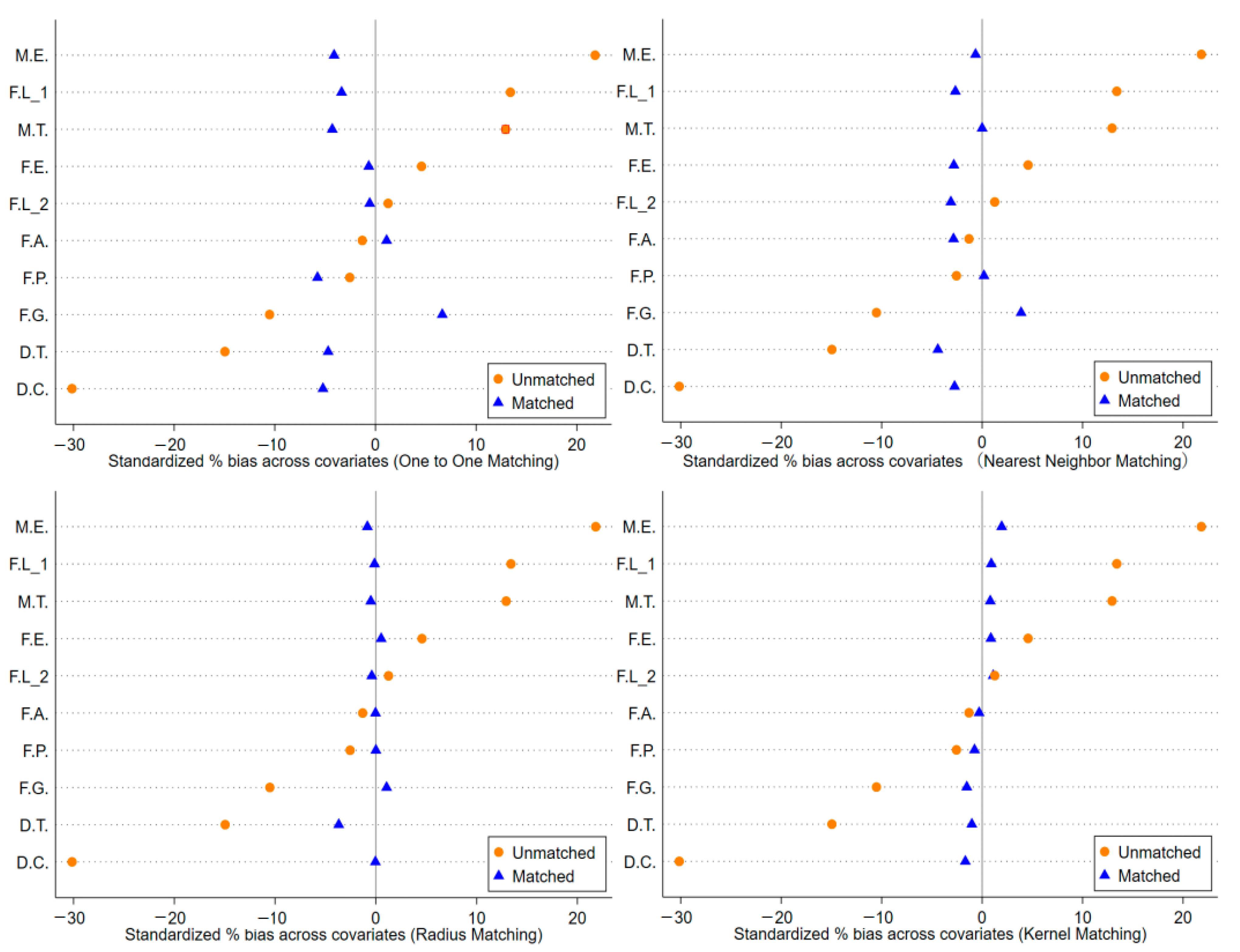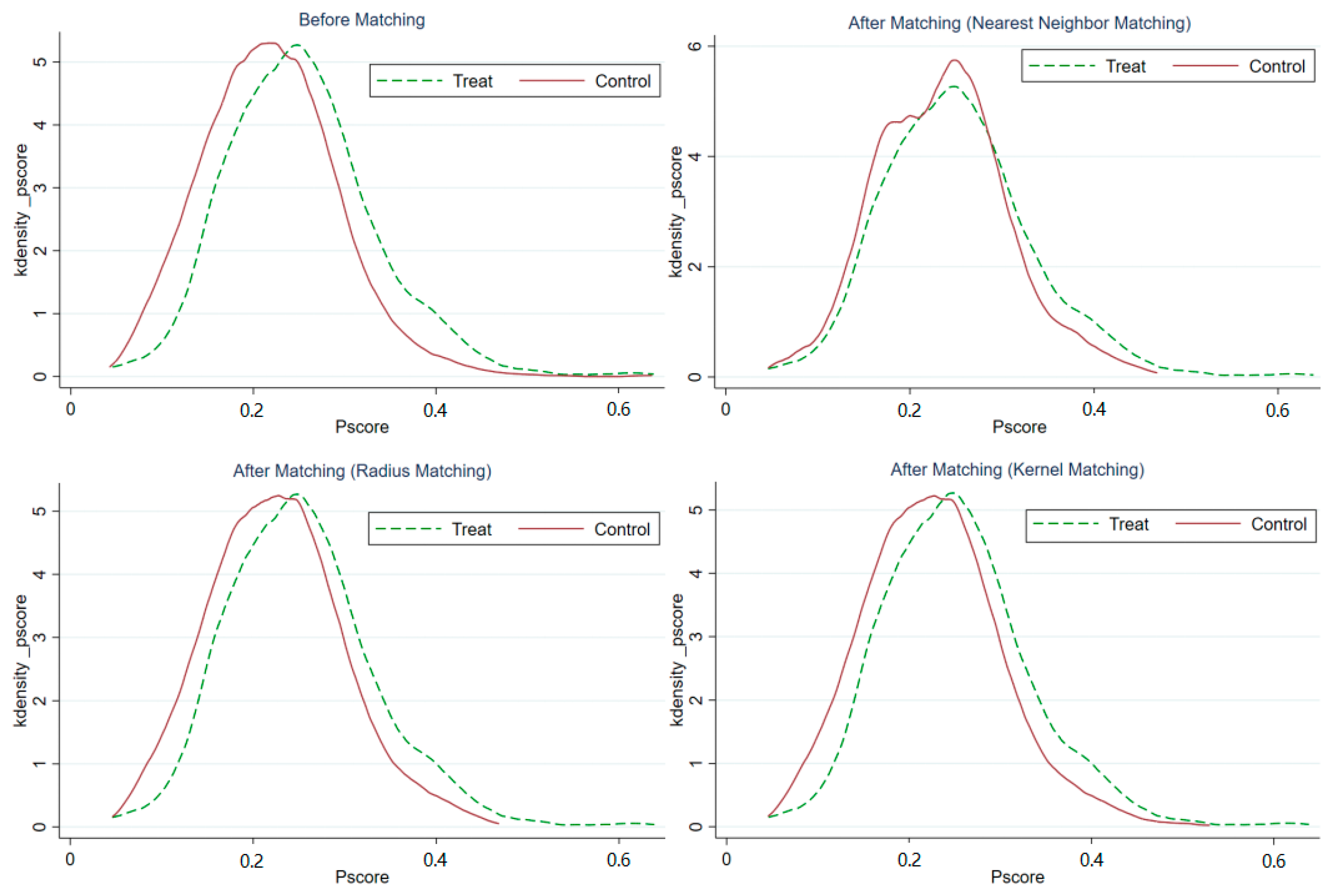1. Introduction
Improving agricultural labor productivity is an important symbol of realizing agricultural modernization [
1,
2]. First, it directly means increasing farm income, which is conducive to promoting the sustainable development of the agricultural economy. Secondly, it can drive farm employment, which is conducive to promoting the sustainable development of agricultural society. At the same time, the green development of agriculture also imposes new requirements on the improvement of labor productivity, which will also be conducive to indirectly promoting sustainable development of agricultural ecology. Family farms are the basis for the functioning of agricultural sectors in many regions of the world [
3] and also serve as an important link between small-scale farmers and modern agriculture in China, especially in the western mountainous areas. The originally intent behind establishing demonstration family farms is to improve agricultural labor productivity, which has important and long-term significance in promoting agricultural and rural modernization and promoting the common prosperity of farmers and rural areas [
4]. Family farms can effectively extend industrial chains, expand supply chains and improve value chains, which plays an important role in helping to eliminate poverty and assisting farmers to raise their income [
5,
6], and it has gradually developed into the important approach of promoting agricultural and rural modernization [
7,
8]. The Communist Party of China (CPC) have always insisted on solving the problems of agriculture, rural and farmers as the top priority of all developmental work [
5]. The implementation of the family contract responsibility system promotes the development of the rural economy in China. However, with the development of the historical process, some problems have been exposed, such as small scale of agricultural management, scattered management, backward agricultural technology and low production efficiency [
9,
10,
11], which make it difficult to elevate the improvement of agricultural labor productivity. Therefore, it is extremely important to find an effective business model that can not only effectively compensate for the shortcomings of traditional small-scale farmer management, but also promote the moderate-scale management of land.
In China, the No. 1 central document of the CPC Central Committee first saw the phrase “family farm” written in as the new type agricultural business entities in 2013 [
12]. Since then, there has been an emphasis on strongly supporting family farm development [
12,
13,
14,
15,
16,
17,
18,
19,
20], which has become an important topic of discussion in the political and academic circles. A series of family farms demonstration cases have been established and popularized [
21]. This initiative is an important channel for the improvement of labor productivity and an important experience in promoting the revitalization of the rural industry. Mountainous areas in western China are the key support areas for the realization of agricultural modernization and sustainable development. In this paper, Tongren city, with the geographic structure characteristic of the western mountain region [
4], is selected as the study area. An empirical test on the causal relationship between demonstration farms and agricultural labor productivity, with a micro-large sample of 1823 family farms and PSM-logit model, is adopted. Additionally, this article attempts to answer the following three questions: (1) What is the labor productivity level on family farms in the mountainous area of western China? (2) Can demonstration farms improve labor productivity? (3) How much room is there for demonstration farms to contribute to improving labor productivity?
The highlights several innovations of this paper are summarized as follows: Firstly, this paper researches the effects of demonstration farm on labor productivity, which has important and far-reaching theoretical value and practical significance for promoting the connection between small-scale farmers and modern agriculture. Secondly, we select Tongren city as the research area. This site has mountainous geographic characteristics and green ecological advantages [
4]. Located in the mountainous area of western China, the area has special value and representational significance. Thirdly, we focus on matching two groups of samples, namely, demonstration farm and non-demonstration farm by propensity score matching (PSM) method, and then calculating the average treatment effect of the matched sample, further examines the sensitivity of PSM estimation results to “hidden bias”. Based on the above innovations, the main academic contributions of this paper can be summarized as follows. The study is not only helpful in that it provides an effective development path for small-scale farmers in mountainous area to increase their income and become wealthy, but also helpfully provides an empirical basis and experiential reference for the development of modern agriculture in China. Finally, it is helpful as it provides a typical case in China for other countries or regions to use for the promotion of sustainable agricultural development.
The rest of the paper is structured as follows.
Section 2 provides a literature review.
Section 3 proposes a Theory and Method.
Section 4 describes the Variables and Data.
Section 5 details the Results and Discussions.
Section 6 summarizes the Conclusions and Implications of this paper.
2. Literature Review
If a researcher looks extensively at the relevant theoretical research and academic exploration in policy and academic circles, they will find that the existing literature mainly comprises relatively rich research into the connotation and extension of family farm, the development of driving forces and factors, the development of efficiency and benefits, and the development of a path and policy proposal for improving labor productivity in family farm. This content lays a solid logical foundation for the research ideas and contents of this paper.
In the literature, there are numerous studies on the problems of connotation and extension of family farms. The development of family farms in Brazil [
22,
23], the Netherlands [
24,
25], France [
26,
27], Japan [
28,
29] and other countries has achieved good results, and the systems and mechanisms used are relatively perfect. The operation mode of first using a pilot and then promoting the system has been adopted in China, and a series of typical cases of family farm development have emerged [
30,
31,
32,
33,
34,
35]. Most studies fully indicate that family farms play outstanding roles and have obvious effect [
5,
6,
7,
35,
36,
37]. They also show the following remarkable characteristics centrally, such as family management, specialized division of labor, socialized cooperation, use of modern technology, enterprise operation, modern farming, market-oriented practice, agricultural commercialization, agricultural mechanization, green management, labor stability, and being agricultural income-oriented, etc. [
38,
39].
The subject of the development driving force and the influencing factors of labor productivity of family farms has attracted a great deal of attention and discussion from academic circles. In general, the development process of family farms is a process of continuously improving labor productivity to improve production power and grant the comparative advantages of low labor supervision cost, good scale benefit, high production efficiency, etc. [
5,
6,
7,
35,
36,
37]. Notwithstanding, the economic, social and ecological benefits of family farms can also be disturbed by various influencing factors [
6,
7,
35,
36,
37,
40,
41]. For instance, mechanisms and tools of agricultural policy, agricultural mechanization, crop establishment, wage labor, quality capabilities of agricultural managers, level of internal management, rural financial credit system, satisfaction of social service demand, support for agricultural science and technology, and quality and safety of agricultural products, etc. [
40,
41,
42,
43,
44,
45,
46]. As it should be, objectively speaking, the development of family farms in different countries and regions at different stages of development is affected by natural, social, economic, cultural, technical and other factors. Family farms also face many resource constraints.
There are many studies on the development efficiency and benefits of the labor productivity of family farms. Some scholars have reached relatively consistent conclusions. Some argue, for example, that welfare emerges as a legitimate element for the analysis of the family farm economy [
47]; others assert that the larger the area of a small-scale family farm is, the greater its economic sustainability will be [
46]. There is a positive correlation between the managing efficiency and economic benefits of family farms, and the management efficiency of family farms that adopt new technologies is relatively higher than that of family farms without new technologies [
48]. The use of demonstration farms has a significant positive impact in terms of improving the develop benefits of family farms, increasing farm income, promoting the sustainable development of family farms, and enhancing the sense of the gain, happiness and security of farmers [
6,
7,
35,
36,
37]. Of course, some scholars also found that the overall level of technical efficiency of Chinese family farms is relatively low and that the efficiency value is not high. There is a large room for improvement in both pure technical efficiency and scale-related efficiency [
9,
30].
There are also many scholars who have given constructive insights into the development path and policy recommendations for improving labor productivity in family farms. The development of family farms is a systematic, ecological, dynamic and sustainable process that needs to combine the internal force and external support of family farms organically [
49]. Scholars should combine these policies with regional agricultural development, improve policy design for family farm development and popularize typical cases of demonstration farms [
5,
35,
36]. We must establish and improve the efficiency improvement mechanisms and incentive and restraint system of demonstration farms [
9]. We should cultivate new types of professional farmers [
37], promote the integration of universities, enterprises and bases through “industry-university-research” cooperation [
6], and cultivate demonstration farms with local characteristics [
36]. At the same time, there is a need to improve farm infrastructure conditions, promote the rational allocation of resource elements, and strengthen agricultural green technology innovation and diffusion [
50] in order to improve the labor productivity and economic sustainability of family farms [
43], ensure the healthy and efficient development of family farms, and then accelerate the advancement of agricultural modernization [
51].
In summary, the relevant research results at the domestic and foreign levels fully demonstrate the effectiveness and persistence of the demonstration farm, and various representative views provide rich theoretical support and empirical borrowing material for the research in this paper and lay the scientific research direction and idea framework. However, it is worth paying close attention to the fact that the following aspects of research are necessary to further deepen and expand our understanding in this area. This is also the unique feature of this paper.
Firstly, from a theoretical point of view, there is at present little to read literature when researching the causal effect of demonstration farm on labor productivity. This paper researches the effect of demonstration farms on labor productivity, a practice that has important and far-reaching theoretical value and practical significance for consolidating the family farm management system, promoting the connection between small-scale farmers and modern agriculture, increasing farm economic income, and advancing agriculture and rural sustainable development. This will also be the logical starting point of the strong argument presented in this paper.
Secondly, in the research into the existing literature on family farms, it can be observed that the eastern, northeastern and central parts of China are often selected as research areas. However, there is little literature on choosing western China as a representative area for research. This paper selects Tongren city as the research area. With mountainous geographic characteristics and green ecological advantages [
4] in the mountainous area of western China, this area has special value and representational significance. It is beneficial to compare the heterogeneity of farm development in the western region with other regions, and also to provide typical cases of farm development for other countries or regions.
Thirdly, it can be seen from the research method used that the existing research on family farms mainly uses small sample analysis. For this reason, the micro-large sample data is adopted in this paper, that is, the empirical analysis based on the micro-large sample of 1823 family farms in the mountainous area of western China with relatively stronger reliability and validity is used. At the same time, this paper focuses on matching two groups of samples, namely, demonstration farms and non-demonstration farms via the PSM method, and then calculating the average treatment effect of the matched sample. In addition, this research further examines the sensitivity of PSM estimation results to “hidden bias”. This helps to avoid bias in the estimation results, which it is necessary to treat with the samples data before empirical research, due to the non-randomness of sample selection.
4. Variables and Data
4.1. Variables Selection and Definition
Due to the difficulty of obtaining complete statistical data on variables, this paper draws on the research experience of other scholars for reference [
6,
7,
35,
36,
37], considers the representativeness, availability and authority of the statistics, and follows the principles of consistency, integrity and scientificity of variables [
4,
57]. In view of these methods, which select the variables closely related to demonstration farms and the labor productivity of family farms, three classes of variable are included as follows. The settings and definitions of the variables are listed in
Table 1.
(1) Dependent variable. Improving labor productivity is the core indicator of agricultural modernization. In real-life applications, promoting the improvement of agricultural labor productivity will contribute to raising the income of agricultural family laborers. This, in turn, promotes the sustainable development of family farms. In view of this, this paper sets the labor productivity (L.P.) as the outcome variable, which is the per capita production value of family farms.
(2) Core independent variable. From a practical point of view, when a family farm is established like a demonstration farm, it means that the farm has complete infrastructure, moderate large-scale management, scientific management, production standards and specifications, obvious demonstrations driving roles, etc. These measures mean that the productivity of the farm is higher than a certain probability of the average level of the whole city, meaning that the per capita income of the farm is higher than a certain ratio of the per capita income of local farmers. Thus, in relative terms, the more obvious the role of demonstration as a driving force is, the more it can actively drive the surrounding farmers to increase their income. Therefore, the demonstration farm (D.F.) is taken as the treatment variable.
(3) Control variable. In this paper, the following covariates that have a close relationship with outcome variable and treatment variable are also selected as control variables to reflect the basic situation of individual characteristics, labor input, operating conditions, experience accumulation, and agricultural environment of the family farm. Examples include head farmer gender (F.G.), head farmer age (F.A.), head farmer education (F.E.), family laborers (F.L_1), farm products (F.P.), farmland (F.L_2), management type (M.T.), management experience (M.E.), farm distance_county (D.C.), farm distance_town (D.T.), etc.
4.2. Data Interpretation and Source
Before introducing the data sources, it is necessary to define the family farm of this paper. The family farm selected in this paper mainly refers to a new type of agricultural business entity identified by the Agriculture and Rural Bureau of Tongren city that takes family members as the main labor force, agricultural income as the main source, and engages in moderate-scale, intensive and commercialized production and management of agricultural land. According to the geographic characteristics of the mountainous area in Western China, this territory mainly includes the following business types, including mountain planting type, dam land planting type, animal husbandry type, aquaculture type, and comprehensive planting and breeding type. Demonstration farms are established on the basis of encouraging farmers to operate independently, cultivated by the township government, recommended by the county government, and approved by the municipal government in areas where meet the conditions of moderate business scale, standardized farm business management, good and safe product quality, significant economies of scale, strong demonstration and driven benefits. Some of the variables were derived from the family farm statistics data of the Agriculture and rural Bureau of Tongren city. Data collection, sorting out and statistical analyses were carried out on some variables by the authors of this study based on the basic statistical data of Agricultural and Rural Bureau of Tongren city. The empirical data used are mainly from the 1823 family farms in Tongren city from 2013 to 2020.
4.3. Descriptive Statistics Analysis
The results of the descriptive statistics analysis of the variables are shown in
Table 2. The statistical results of the mean, standard deviation, skewness, kurtosis, and number of samples from the control group and treated group are displayed in detail in the table, respectively. On the whole, the distribution of most variables is relatively concentrated, and the degree of dispersion is small. However, it is also found that the standard deviation of farm land (F.L_2), labor productivity (L.P.), farm distance_county (D.C.), and farm Distance_Town (D.T.) are relatively high, which shows that there are some differences between farm land, labor productivity, farm distance_county, and farm Distance_Town in the sample data to some extent. Meanwhile, farmland (F.L_2), labor productivity (L.P.), and farm distance_town (D.T.) have higher positive skewness and positive kurtosis, as the results show that there are many extreme values in the data series of the above variables, there are outlier data values, and the distance between the data and the mean value is relatively large. In addition, it is worth mentioning that the average labor productivity of the treated group is 2.8 times higher than that of the control group.
6. Conclusions and Implications
In this paper, based on a sample of 1823 family farms in the mountainous areas of western China, the causal relationship of demonstration farm on labor productivity was empirically tested. Additionally, the PSM-logit model and sensitivity analysis wwere used. The conclusions of this paper are as follows.
Firstly, as the average agricultural labor productivity of the demonstration farm is CNY454898, which is 2.8 times higher than that of the non-demonstration farm, hypothesis 1 has been verified. Secondly, there is a significant positive correlation between demonstration family farm and agricultural labor productivity. Compared to family farms that did not obtain the demonstration farm, the use of demonstration farms in the case of adding all control variables, which can promote farm income by CNY301458 on average, gave significant values at the level of 1‰, verifying hypothesis 2. Thirdly, in the matched sample, and under scenarios controlling for other covariates, the use of demonstration farms, was shown to significantly enhance farm income of CNY285108, CNY288509, and CNY291077 on average, respectively. After taking the radius matching, the kernel matching, and the nearest neighbor matching, the average treat effect on the treated of matched sample passed the 1% significance level test. When propensity score matching is performed, most of the observed values are within the common support by the propensity score, indicating that the matching results have passed the balance test. Meanwhile, the sensitivity analysis results fully reveal that there is a close association between the demonstration farm and labor productivity, and the estimation results obtained in this paper by PSM method has good robustness, and the conclusions of the research are reliable and credible, meaning that hypothesis 3 has been verified. However, objectively speaking, the above research results may only be applicable to the mountainous area of western China and may not necessarily apply to the eastern or central regions of China, which may be greatly related to the varying degrees of differences in agricultural resource endowment, agricultural industry structure, agricultural industry resilience, and agricultural development potential in different regions of China.
Based on the above findings, the policy implications of this research are significant. First of all, farmers should actively develop family farms according to local conditions, and vigorously cultivate and develop demonstration farms [
6,
7,
9,
35,
36,
37], innovate experimental and demonstration models from the perspective of regional coordinated development [
60], step up, publicize and promote unceasingly the typical cases and experience of demonstration farm, so as to encourage family farms to continuously improve labor productivity. Secondly, authorities should encourage family farms that have not been obtained demonstration farm to continue to give play to their comparative advantages, aggregate the optimized allocation and agglomeration effect of various resources, strengthen the professional skills education and management ability of farm owners, improve the quality and competitiveness of farm products, carry out continuous moderate scale management, summarize and promote the typical experience of the farm. Thirdly, on the basis of fully considering the factors of family farms, such as industrial foundation, development type, land continuity, convenient transportation, etc., authorities should innovate the management modes of mountainous planting or breeding and explore industrial models of mountain stereo agriculture, actions which in turn contribute to improving the labor productivity of family farms.
In addition, based on policy implications, this paper proposes the following future direction. The local government and its agricultural and rural departments should further improve the top-level design and supporting policies for high-quality development of family farms, optimizing and improving the developmental planning and construction system of family farms according to local conditions, strengthening the demonstrative establishment of family farms, accelerating the linkage and integration of family farms with other new type agricultural business entities, advancing high-quality development of agricultural modernization [
61], and promoting sustainable development of agricultural and rural [
62].













